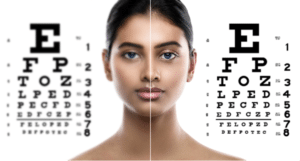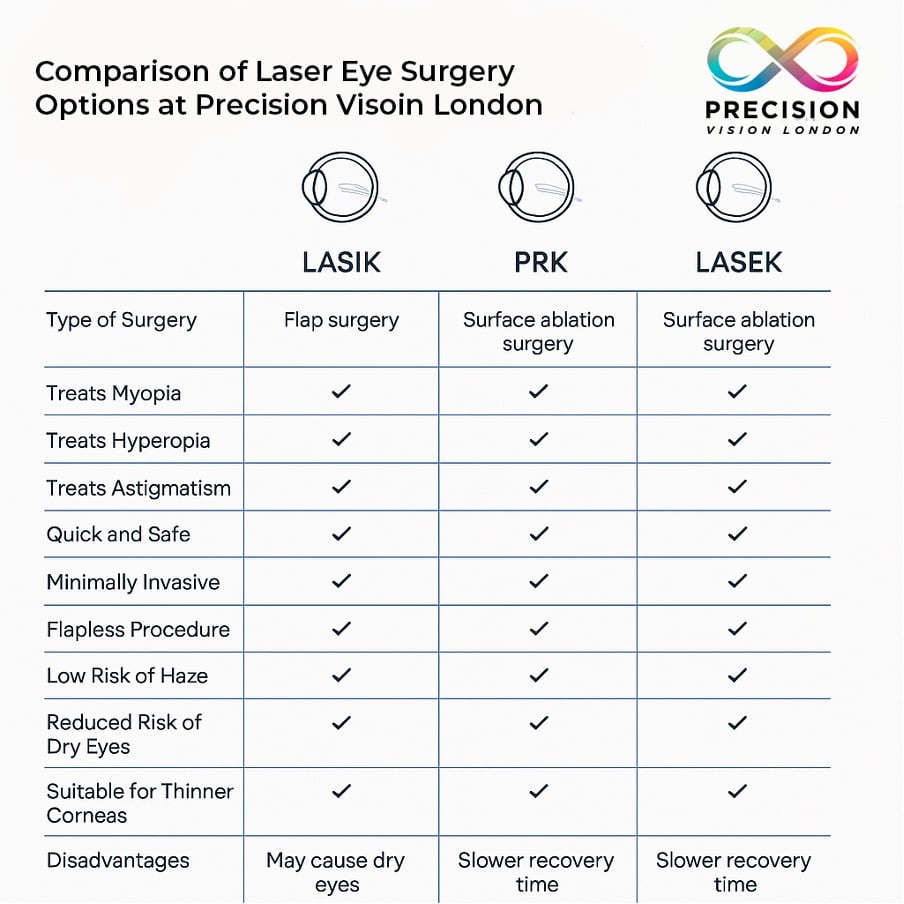Laser eye surgery results last a long time, and many people want to know if the effects are permanent. The procedure permanently changes your cornea’s shape, and these structural changes usually last throughout your life. All but one of these changes stick around forever, though a small number of patients might need another operation if their vision wasn’t perfectly corrected the first time.
Your age plays a big role in how long laser eye surgery results will last. The surgery creates permanent changes, but your eyes naturally change as you age. The American Refractive Surgery Council reports that about 35% of individuals needed additional treatment within 10 years, though most patients stayed happy with their results. People who get the surgery in their 20s or 30s might still need reading glasses later. This happens because of presbyopia, a natural condition that affects everyone’s eyes around age 45.
This piece explains why laser eye surgery works as a lasting vision solution. You’ll learn what to expect after your procedure and whether starts from £2250 makes sense when you think about decades without glasses or contacts.
How Laser Eye Surgery Works and Why It’s Considered Permanent
Laser vision correction creates permanent changes to your eye’s structure, but your vision might still change as time passes. Let’s explore what actually happens during these procedures to understand this better.
What happens during LASIK and LASEK?
The surgeon starts a LASIK (Laser-Assisted In Situ Keratomileusis) procedure by creating a thin flap in the cornea’s surface. They use either a microkeratome blade or a femtosecond laser to do this. The surgeon folds back this flap to reach the stroma, which is the middle layer of the cornea. LASEK (Laser-Assisted Sub-Epithelial Keratectomy) works differently. The surgeon loosens and moves the thin outer corneal layer aside instead of making a flap.
Both procedures use an excimer laser that removes tiny amounts of corneal tissue with precision. This laser produces cool ultraviolet light and breaks the molecular bonds between cells without hurting nearby tissue – a process called photoablation.
How the cornea is reshaped permanently?
The surgeon reshapes your cornea based on your specific vision problem. The laser flattens the cornea’s center to fix nearsightedness (myopia). It steepens the center to correct farsightedness (hyperopia). The laser smooths the cornea into a more regular shape to address astigmatism.
These changes last forever because corneal tissue doesn’t grow back. The removed corneal cells never return, which means the vision correction from reshaping stays stable.
Why vision may still change over time?
The corneal reshaping lasts forever, but your eyes keep aging naturally. Most people develop presbyopia between the ages of 40-45. This condition makes the eye’s lens less flexible and creates difficulty focusing on nearby objects. Presbyopia affects everyone, whether they’ve had laser eye surgery or not.
Your original vision problems might also get worse as time passes. People with stronger prescriptions or active myopia at the time of surgery could see some changes later. Eye conditions like cataracts and glaucoma can also develop on their own and affect your vision years after the surgery.
How Long Does Laser Eye Surgery Last For Different Age Groups?
Age is a vital factor that determines how long laser eye surgery results will last. Your vision stability and natural aging process affect the duration of your results after the procedure.
In your 20s and 30s: stability and risks of regression
Laser eye surgery typically works best for younger patients who enjoy more stable, longer-lasting results. People in their 20s and 30s usually see excellent outcomes because their vision has stabilised. Over half of all LASIK procedures are performed during these years, and many patients keep their clear vision for decades.
All the same, regression can occur. Higher original prescriptions might lead to more regression as time passes. The corneal epithelium grows steadily over flattened regions during the months after surgery, which can gradually change your vision. This epithelial response becomes more noticeable in treatments with larger corrections.
In your 40s and 50s: presbyopia and reading glasses
Presbyopia starts developing around age 40, whatever your eye surgery status. Your eyes’ lens becomes stiffer and loses flexibility, which makes focusing on close objects harder. So even after successful laser vision correction, you’ll probably need reading glasses.
You do have other choices. Monovision LASIK fixes one eye for near vision and one for distance, which might eliminate your need for reading glasses.
In your 60s and beyond: cataracts and lens replacement
About half of people have some clouding in their eyes’ lens by age 60, and this number rises to 70% after age 75. LASIK doesn’t prevent or slow down cataract development. Cataract surgery might become necessary if cataracts form after your laser procedure.
A study of 424 LASIK patients aged 40 to 60 showed similar results across age groups, though older patients needed enhancement procedures more often. Doctors usually recommend cataract surgery instead of LASIK for seniors with cataracts. They might use multifocal lens implants to correct both distance and near vision.
What To Expect 1, 5, And 10 Years After Surgery

Image Source: Barnet Dulaney Perkins Vision Correction
Laser eye surgery’s effects become clear over the first ten years. Most patients keep their improved vision for 10–20 years after their procedure. Let’s get into what you can expect as time goes by.
How often touch-ups are needed?
Modern techniques have kept touch-up rates surprisingly low. Only 1-2% of patients need adjustments in the first year. After that, the chance drops to about 1% each year. Nine out of 10 people never need a second operation.
People who need touch-ups usually face these issues:
- Too much or too little correction of their vision problems
- Natural vision changes not related to surgery
- Left-over vision problems from the first treatment
Your chance of getting touch-ups depends on your corneal thickness and eye health. Doctors suggest waiting until your vision stays the same for 3-6 months before you think about any adjustments.
Side effects: when they show up and fade away
Side effects usually pop up right after surgery but go away within months. Right after surgery, you might notice dry eyes, fuzzy vision, and sensitivity to light. Seeing halos and starbursts around lights at night is also common early on.
Dry eyes and light sensitivity usually clear up in 3-6 months. Most side effects fade in the first few months, though some patients might have lasting issues. Note that serious problems with vision are quite rare.
What to expect during recovery?
Your healing follows a clear path:
- Day 1-2: Your first checkup shows how healing starts
- First month: Your vision may change as swelling goes down
- 3-6 months: Vision usually settles into place
- 12 months: Final checkup confirms your results
Laser eye surgery’s lasting power isn’t simple to explain. The changes to your cornea stay put, but your eyes still age naturally. Studies show most people stay happy with their results and keep stable vision years later.

Cost Vs. Longevity: Is Laser Eye Surgery Worth It?
The decision to get laser eye surgery involves careful evaluation of both immediate costs and future benefits. A clear understanding of the financial aspects will help you decide if permanent vision correction is worth the investment.
How much does laser eye surgery cost?
Laser eye surgery prices in the UK range from £2200 to £3800 per eye based on the procedure type. A standard LASIK procedure costs about £2200 per eye, while the advanced SMILE surgery costs around £2,595 per eye. There’s also Presbyond that helps with age-related reading vision problems, which costs approximately £2,895 per eye.
Premium clinics like Precision Vision London charge £2,200 per eye. These higher rates reflect the surgeon’s expertise and state-of-the-art technology. Budget clinics might advertise lower prices but often add extra charges for basic services.
What’s included in the price (consultation, aftercare, enhancements)
The best clinics provide complete packages that go beyond just the surgery. These packages usually include:
- Original consultation (free to £300)
- The surgical procedure
- Aftercare medications and eye drops
- Follow-up appointments (3-12 months)
- Enhancement procedures within a set timeframe if needed
You should always check what each quote includes to avoid any surprise costs later.
Comparing the cost to years of glasses or contacts
The long-term savings from laser eye surgery might surprise you. Contact lens users spend £288 to £660 every year just on disposable lenses. This adds up to £2,880 to £6,600 over ten years, without counting inflation.
The costs don’t stop there. Contact lens fitting appointments (£20-£50) and yearly check-ups (£20-£50) can add £100 or more annually. Over the years, glasses and contacts could cost more than £23,824 for 30+ years of use.
Laser eye surgery becomes both a lifestyle upgrade and a smart financial choice that could pay for itself in 10-14 years.
Can Laser Eye Surgery Be Repeated Or Enhanced Later?
You can get laser eye surgery again if your vision changes over time. This option to boost your vision gives peace of mind to anyone who wonders if laser eye surgery results will last forever. Your original procedure’s permanence doesn’t stop you from getting more corrections later.
What is LASIK enhancement?
A LASIK enhancement works like a touch-up procedure that fine-tunes your original surgical results. The enhancement process is different from your first surgery. Your surgeon gently lifts the original flap created during your first procedure instead of making a new corneal flap. The flap-lifting doesn’t hurt and usually takes just a minute or two.
Patients need enhancements for two main reasons: they notice an early “refractive miss” right after surgery, or their eye’s lens changes naturally years later. Surgeons typically wait until a patient’s vision stays stable for at least three months before they think about any enhancement
Enhancement rates stay surprisingly low. Only 1-2% of patients need more treatment in the first 12 months, and there’s about a 1% chance each year after that.
When is refractive lens exchange (RLE) a better option?
RLE often works better than a LASIK enhancement for patients over 40, especially when they have presbyopia (trouble focusing on close objects) . This option becomes more valuable after age 45 when presbyopia has advanced substantially.
RLE swaps out your eye’s natural lens for an artificial intraocular lens (IOL), like in cataract surgery. Older patients get several key benefits:
- It fixes multiple vision problems at once (myopia, hyperopia, astigmatism)
- You won’t develop cataracts later
- You see clearly at all distances with the right lens choice
RLE might be your best choice if you’ve had LASIK before but now have trouble seeing things up close and show signs of early cataracts.
How safe is repeat surgery?
Doctors call repeat laser eye surgery safe as long as you have enough corneal tissue left. Surgeons usually lift the existing flap for touch-ups within two years of your original procedure. After two years, many prefer LASEK or PRK procedures because these are less likely to cause epithelial ingrowth (surface cells growing under the flap).
The thickness of your cornea determines how many repeat procedures you can safely get. Each laser treatment makes your cornea thinner, so you’ll eventually reach a minimum safe limit.
Enhancement surgeries most commonly cause dry eyes, possible overcorrection, and corneal problems if done too often. All the same, serious issues like vision loss are very rare – less than 0.01%.
Conclusion
Laser eye surgery ranks among the most permanent vision correction options you can get today. This piece shows that the corneal reshaping lasts forever, but your eyes naturally keep aging whatever you do. Most patients see clearly for 10-20 years after their procedure. Age-related changes like presbyopia still show up around your mid-40s.
The numbers make a strong case for laser surgery when you look at its one-time cost versus years of glasses and contacts. Contact lens users spend between £288 and £660 each year. That adds up to £23,824 over 30+ years. Laser eye surgery pays for itself in just 10-14 years.
Modern techniques have made touch-ups rare. All but one of these patients never need a second operation. Under-correction or natural vision changes cause most follow-ups. Refractive lens exchange works better than LASIK touch-ups for older patients with presbyopia.
Your laser eye surgery results have staying power, but there’s more to the story. The physical changes to your eyes stay put while natural aging continues. Your vision needs might change as time passes, especially after 40. This fact doesn’t make the procedure less valuable – it just means you should set realistic expectations.
Looking for a lasting solution to your vision problems? Our team at Precision Vision London offers expert guidance, cutting-edge technology, and complete aftercare. We help you make smart choices about this life-changing procedure.
Talk to qualified eye surgeons who understand your specific needs before choosing any vision correction. Laser eye surgery can’t stop time, but it gives you freedom from glasses and contacts for many years. Countless patients say this benefit alone makes it worth every penny.
FAQs
Q1. How long do the effects of laser eye surgery typically last?
Laser eye surgery results are generally long-lasting, with most patients maintaining improved vision for 10-20 years after the procedure. However, natural age-related changes can still affect vision over time.
Q2. Is it possible to have laser eye surgery more than once?
Yes, laser eye surgery can be repeated if necessary. Enhancement procedures are available for those who experience vision changes after their initial surgery, though fewer than 10% of patients require a second operation.
Q3. At what age does laser eye surgery provide the most stable results?
Patients in their 20s and 30s typically experience the most stable, long-lasting results from laser eye surgery. This is because their vision has usually stabilised, and they’re less likely to experience age-related vision changes immediately after the procedure.
Q4. Will I still need reading glasses after laser eye surgery?
Around age 40, most people develop presbyopia, which makes focusing on close objects difficult. Even after successful laser eye surgery, you may need reading glasses as this is a natural age-related change unrelated to the cornea’s shape.
Q5. How does the cost of laser eye surgery compare to long-term use of glasses or contacts?
While laser eye surgery has a higher upfront cost, it can be more economical in the long run. The procedure typically pays for itself within 10-14 years when compared to the ongoing expenses of glasses and contact lenses over several decades.
References
- https://pmc.ncbi.nlm.nih.gov/articles/PMC5887600/
- https://www.healthline.com/health/eye-health/lasik-for-presbyopia
- https://www.webmd.com/healthy-aging/lasik-after-60
- https://www.fda.gov/medical-devices/lasik/what-should-i-expect-during-and-after-surgery
- https://www.medicalnewstoday.com/articles/what-to-know-about-lasik-recovery-and-its-effects
- https://pubmed.ncbi.nlm.nih.gov/34241701/
Authors & Reviewer
-
 Olivia: Author
Olivia: AuthorHi, I'm Olivia, a passionate writer specialising in eye care, vision health, and the latest advancements in optometry. I strive to craft informative and engaging articles that help readers make informed decisions about their eye health. With a keen eye for detail and a commitment to delivering accurate, research-backed content, I aim to educate and inspire through every piece I write.
-
 Dr. CT Pillai: Reviewer
Dr. CT Pillai: ReviewerDr. CT Pillai is a globally recognised ophthalmologist with over 30 years of experience, specialising in refractive surgery and general ophthalmology. Renowned for performing over 50,000 successful laser procedures.

